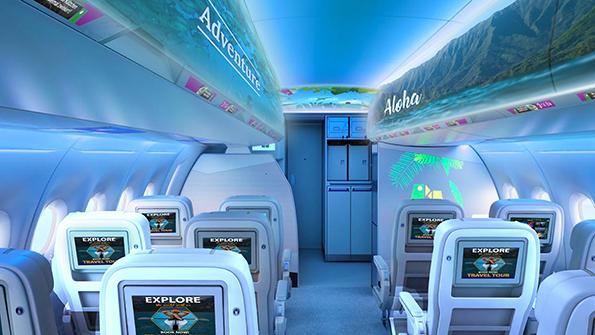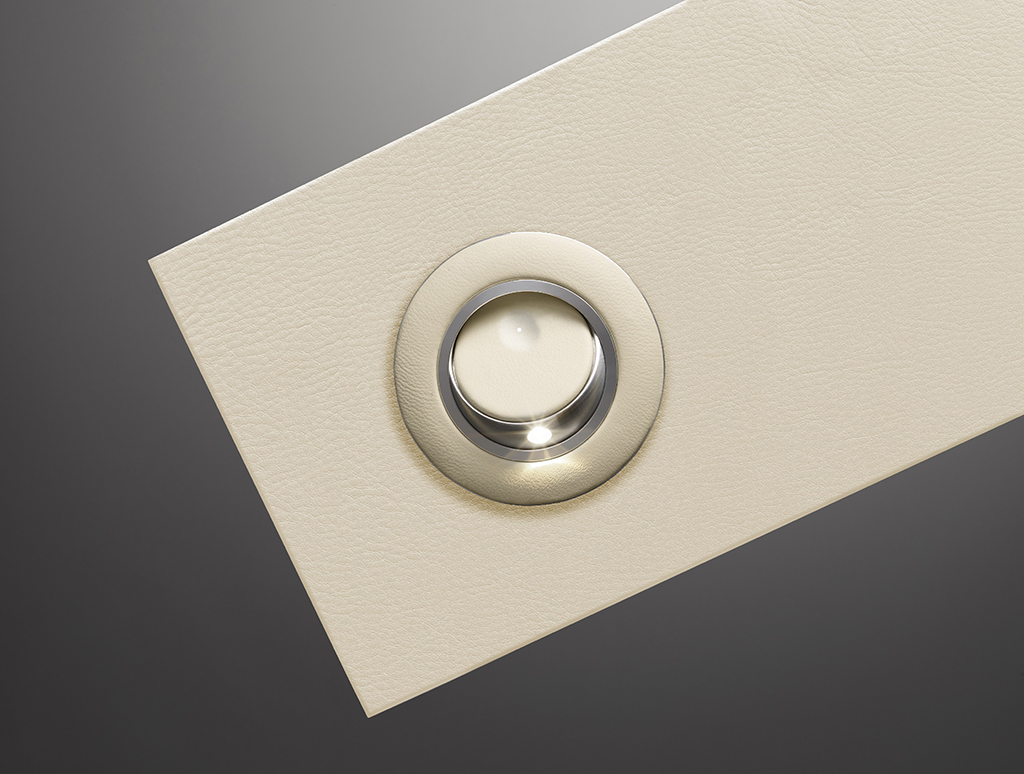LED Airline Cabin Lighting Advances Toward Fashion And Flexibility

Diehl Aviation’s “In-Cabin Experience Enhancer” enables cabin features to be used as projection surfaces for displaying dynamic and changing content.
As airlines and business jet operators upgrade their cabins and order new aircraft, more are considering light-emitting diode lighting as an option for both line maintenance and retrofits.
While light-emitting diode (LED) lighting itself is not new to the industry, the technology behind the science continues to mature and develop, according to Matthew Opisso, director of business development and strategy and value stream leader for lighting solutions at Collins Aerospace. “LEDs are getting smaller in both size and weight while simultaneously, the quality and quantity of light output has improved along with increases in both reliability and useful life of bulbs,” he says.
Opisso points out that color drift can occur in older LEDs, resulting in inconsistent lighting across the cabin and a dated, tired appearance. Added thermal compensation, he explains, can mitigate these effects and slow the bulb aging process, producing more vibrant, consistent coloring and extending the useful life of the bulb. He reports that Collins is adding LEDs to its Hypergamut wash lighting to produce a spectrum of color and saturation that approaches a “near-perfect” color rendering index (CRI) of 99, versus 85 for legacy systems.
“LED system design offers additional lighting functionality and control, a straightforward product installation and FAA approval,” says Eric Dahlinger, business development manager at Wichita-based PWI. “Using the existing aircraft wiring eases installation, minimizes technician bench time and gets the aircraft back into service quicker.”
Among the “most exciting aircraft lighting trends,” Dahlinger says, is the upgraded functionality that LED systems offer.
“LEDs enable passengers and crew to share control of the cabin environment, such as the lighting color. In some first-class cabins the passenger has total control of his immediate environment and can create more personalized lighting,” he says. “In business aviation, control over cabin light colors in defined areas of the cabin—and preprogramming lights over the course of longer flights—are becoming more common.”
Dahlinger says that today’s LEDs require only 28 volts, which translates to less demand on power generation and lower fuel consumption. At the same time, LEDs provide weight savings over the fluorescent systems that they are replacing amid parts scarcity, rising costs and susceptibility to electromagnetic and radio frequency interference—a source of annoying buzzing and flickering.

“The weight savings varies by light length and the power supply used,” Dahlinger says. “However, we could average the weight savings to around 1-1.5 lb. per light install. For a commercial airliner, using 200 lights per aircraft, that is anywhere from 200 to 300 lb. total weight savings just for switching to LEDs. For a business jet, with an average of 40 lights, that is 40-60 lb. of weight saved.”
Keith Hanzlik, director of aviation products and programs at Prizm Aircraft Lighting, notes that one important cabin lighting trend is to make the power and control units as small as possible and capable of deployment across all platforms.
Hanzlik says Prizm has developed a lighter-weight cabin lighting product by using off-the-shelf aluminum extrusions and flexible LED stripping. “Also, the controller is lightweight aluminum, with minimal internal design, meaning no moving parts or filters,” he explains. “The number of controllers varies by aircraft. For example, on a Boeing 757, there are three.”
Hanzlik also agrees that LED technology provides a better passenger experience. “Practical mood [lighting] that enhances the passenger experience is one of the trends, such as the softer-feeling hue of blue when the lights come on in the evening hours versus sudden bright white,” he says. “Prizm has done this on essentially every install by giving the user the ability to create the moods and scenes to best align with their needs.”
Similarly, Hanzlik points to “true smart lighting,” in which the installer can configure the lighting to function exactly as the user requests.
He also reports that Prizm has achieved power reduction compared to legacy cabin lighting through a combination of LED systems and lighting controllers designed to enable the LEDs to draw much less power. The controllers house the software that controls the colors, shading and the on/off function.
Hanzlik stresses that the only maintenance would be in the form of a software upgrade. “The only time a customer would need to update the software would be if we came out with a new version—or they want to update [the moods] themselves,” he says.
Asked about new cabin lighting developments, Hanzlik reports that the company’s next product iteration will incorporate a “customer-focused, open-source configurator,” as well as an avionics interface to track time of day, flight duration and time zones to align the circadian color and intensity of the cabin lights.

Philip Fischer, vice president of industrial, aviation and automotive at Schott, notes a trend toward linking individual functional and ambient lighting solutions to general cabin lighting systems. “Ultimately, this means that the next generation of aviation lighting will introduce even more features into the cabin, seats and monuments,” he says.
For example, Fischer points to Schott’s Jade Reading Light, developed with designer PriestmanGoode, which offers a “functional, classical reading light” combined with an integrated ambient light to “create a special atmosphere within a business or first-class seat.” He refers to Jade as “smart” because it interlinks with cabin and seat scenarios. “For example, when you adjust the position of your seat, the light beam automatically follows,” he explains. “This is the type of innovation that airlines are looking for.”
The Jade Reading Light has been designed to reduce ownership costs greatly as well. Made of “long-lifetime glass and metal,” as Fischer puts it, it uses a sleek glass surface, operated by touch like a smartphone. “With no moving or tilting parts, costs for maintenance and repair can be reduced by up to 90% compared to traditional flex-and-stay reading lights,” Fischer says.
In a further development, Fischer reports that at the Aircraft Interiors Expo trade show this June in Hamburg, Schott will showcase the latest innovations to its Opal Reading Light series—also a joint Schott-PriestmanGoode project.
“This light perfectly matches seat colors and materials thanks to the integration of leather, faux leather or alternatively fabric. This allows the reading light to be almost invisible when turned off, making it fit harmoniously into the overall seat design,” Fischer says. “Passenger-friendly usability is achieved thanks to a covered on/off dimple. An orientation light can also be integrated.”
Jan Petersohn, who leads business development for cabin systems at Diehl Aviation, says the importance of lighting as a contributor to cabin design and passenger well-being is “fully recognized by everybody in the industry.” In addition, he cites the use of full-color-capable lighting in all-new aircraft, along with flexible surface lighting incorporating cabin-branding features via colors and/or patterns. “More application[s] of lighting features make it possible for the airline to stand out in the market,” he adds.

As a reflection of the trends, Petersohn describes Diehl Aerospace’s new Airspace cabin for the Airbus A320 Family, which uses the latest LED technology for the entrance area, the cabin and the lavatories. “This makes the areas look significantly larger, more modern and brighter,” he says. “In addition to the impressive main lighting and the flexible light strips along the contour of the overhead compartments, the highlight is the Hero Light, which runs in the middle.” Petersohn adds that the 40-cm-wide (16-in.) strip light can be customized for each airline customer. Airspace also includes comfort colors and dimmable lights.
Petersohn predicts that, along with further refinement of current LED lighting technologies, digital surface lights in the cabin may at some point replace today’s lighting systems.
“A surface light with a customizable printed pattern is probably a good example of an intermediate step for such a technological journey,” Petersohn says. “If such a pattern is digital, and if the design can be adjusted to suit a rebranding [for] other airlines, or adapted to seasonal themes, the possibilities are endless.”
He adds that “intermediate steps in that direction will be available by the middle or end of this decade. . . . The technologies of lighting, displays and projection will merge to form a combined technology which is capable of providing all benefits at once,” he says.
While conventional LED lights use considerably less energy and are lighter-weight than older-technology systems, further savings are also possible. A good example is GuideU, a Lufthansa Technik proprietary product powered by photoluminescence. The light strips are charged automatically by all the ambient light available on the aircraft, including natural and cabin light. “Once charged, they glow for a very long time in the dark,” says Torben Biehl, head of GuideU and lighting at Lufthansa Technik.
Lufthansa Technik introduced its initial GuideU “Classic” series in 1995, but Biehl points out that the product is now in its third generation with its “1000” series. Developed as a floor path marking system, GuideU mainly consists of a light strip overlaid on a foam filler to adapt to different heights of floor covering. “GuideU’s nonelectric solution saves a lot of weight compared to electrical marking systems that would also require electric wiring or connectors,” Biehl explains. “When we designed the latest generation of GuideU, we focused on further weight and cost optimizations. As a result, the GuideU 1000 Series saves up to 60% of weight compared to its predecessors thanks to thinner, smaller strips and the use of weight-optimized materials.”
Biehl says GuideU is completely maintenance-free due to the photoluminescence technology, which is independent from any source of electricity. “Consequently, there is no wear or degradation during the charging/discharging process,” he says. “Once GuideU is installed, it simply works. There is no maintenance or check routine required during the entire operating life of the aircraft.”
Biehl also reports that the latest generation of GuideU has moved beyond straight strips and single colors. “We have developed a few unique technologies in order to provide our customers with highly customized solutions that fulfill more extravagant design ideas for aircraft cabins,” he notes. “With ‘Colour-Curve,’ for example, we offer curved strips that exactly follow the shape of interior elements such as bars and seat shells. With ‘CustomFit,’ we also implement the pattern of the installed carpet to the system to perfectly match the guiding strips to the overall design of the aircraft’s cabin.”






